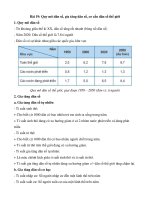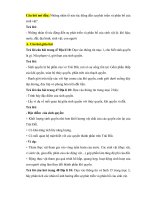Chapter 15: microbiological processes
Bạn đang xem bản rút gọn của tài liệu. Xem và tải ngay bản đầy đủ của tài liệu tại đây (209.36 KB, 11 trang )
Solutions: Environmental Chemistry - a global perspective 4th Edition
Chapter 15
Microbiological processes
PROBLEMS/SOLUTIONS
1.
Given that the Henry’s law constant, KH, for oxygen in water at 25ºC is 1.3 × 10 –8 mol L–1 Pa–1, explain
why a biological oxygen demand (BOD) value of > 5 mg L–1 is indicative of contaminated water.
Solution
KH = 1.3 x 10-8 mol L-1 Pa-1 (for O2 in water at 25ºC)
Show that BOD > 5 mg L-1 indicates contamination.
Consider a 1 L water sample and calculate the concentration of oxygen in equilibrium with the atmosphere
(see Henry’s Law, Chapter 11, Equation 11.2)
The partial pressure of O2 is first determined by:
PO2 = (Pº – PH2O) X O2
PH2O at 25ºC = 3.2 x 103 Pa
Pº = 101 325
XO2 = 0.2095
PO2 = (101 325 - 3200) x 0.2095 = 2.06 x 104 Pa
Now using Henry's law, the concentration of oxygen in the water at 25oC can be determined.
[O2] = KHPO2 = 1.3 x 10-8 mol L-1 Pa-1 x 2.06 x 104 Pa
= 2.67 x 10-4 mol L-1
or
= 8.6 mg L-1
( x 32.0 g mol-1 x 1000 mg g-1)
(ppm)
Therefore in one litre of water there is a potential of having 8.6 ppm O 2 dissolved at 25ºC.
The BOD value represents how much oxygen is consumed during the 5-day test period.
In this case a BOD of 5 mg L-1 (or greater) would result with the water having a final concentration of 3.6
mg L-1 O2 (or less). This concentration of O2 is insufficient to support some forms of aquatic life and the
water is said to be contaminated.
Consider dissolved organic matter to have the generic formula {CH2O}. For a 1 mg L–1 (as C) aqueous
solution of organic matter, calculate the mg of dissolved oxygen in the same volume required to
oxidize it completely. Use this calculation to establish a relation between COD and DOC. Repeat the
calculation using the generic formula for dissolved humic material (Fig. 12.3). Assume reaction of only
the carbon and hydrogen in the humic material.
Solution
2.
see Chapter 12, Figure 12.3
1 mg L-1 (as C) converts to 8.33 x 10-5 mol L-1 (as C)
130
Solutions: Environmental Chemistry - a global perspective 4th Edition
Chapter 15
Microbiological processes
{CH2O} + O2 → CO2 + H2O
consider 1 L of solution:
We therefore have 8.33 x 10-5 mol of C or {CH2O} and therefore 8.33 x 10-5 mol of O2 are also required.
The mass of O2 can now be determined.
8.33 x 10-5 mol (O2) x 32.0 g mol-1 x 1000 mg g-1 = 2.7 mg of O2
Therefore each 1 ppm of C (or DOC) in 1 L of solution requires 2.7 mg of oxygen (COD)
Using a M.W. of 1056 g mol-1 and formula of C57H46O18N2, determined from Figure 12.3, but considering
only the oxidation of C and H gives:
{C57H46} + 68.5 O2 → 57 CO2 + 23 H2O
For 1 ppm as C
This again means having
8.33 x 10-5 mol C or 8.33 x 10-5/57 = 1.46 x 10-6 mol of {C57H46} and
8.33x10-5 / 57 x 68.5 = 1.00 x 10-4 mol of O2
1.00 x 10-4 mol of O2 x 32 g mol-1 x 1000 mg g-1 = 3.2 mg of O2
Therefore each 1 ppm C from humic material requires 3.2 mg of oxygen (COD).
The increased amount of oxygen is a result having a higher C:O molar ratio in the humic material formula
vs. the generic formula CH2O.
3.
In the iron fertilization experiment to increase growth of phytoplankton in the oceans, what chemical
species of iron would you expect to be present at equilibrium, if the iron was initially added as iron(III)
chloride?
Solution
Given that the oceans have a pH of around 8.3 and a pE in the range of 8-12, it would be expected that the
predominant form of iron initially introduced would be in the form of precipitated amorphous iron(III)
hydroxide. As time goes on the iron species that would be in equilibrium would include, Fe(OH)3, ironorganic matter complexes, various other iron hydroxyoxides and an exceedingly small amount of Fe 3+ (aq) .
A total average concentration of iron in the oceans is 1.7 x 10 -9 mol L-1.
4.
For an organic-rich soil, under controlled conditions in the laboratory at temperatures maintained in the
mesophilic ranges, 20 to 30ºC, the rate of carbon dioxide production commonly ranges from 5 to 50
mg CO2 per kg soil per day. Using these data estimate the number of kg of carbon dioxide released
from a 1 ha field under the same temperature conditions.
131
Solutions: Environmental Chemistry - a global perspective 4th Edition
Chapter 15
Microbiological processes
Solution
CO2 released from a 1 ha field? Range of emission rates 5-50 mg kg-1 day-1
Use an average value of 27.5 mg kg-1 day-1
Assume a depth of 0.20 m for the active soil which covers 100 m x 100 m (1 ha)
The volume of soil being considered is 2000 m3 (assume a bulk density of 1.2 g mL-1)
1.2 kg L-1 x 2000 m3 x 1000 L m-3 = 2.4 x 106 kg (of soil)
27.5 mg kg-1 day-1 x 1 day x 2.4 x 106 kg = 6.6 x 107 mg CO2 (or 66 kg CO2)
66 kg of CO2 is produced from the 1 ha field during one day. This value would, of course, depend on many
factors including the nature and content of OM in the soil, moisture, texture etc., as well as on the ambient
temperature.
5.
‘Mineralization’ refers to the process by which organic forms of an element are broken down and
converted to inorganic species. In environmental situations this is most often a microbiological
process. For nitrogen, indicate what forms of the element might be present in water or soil as reactants
and products of the mineralization process.
Solution
Reactants:
(NH2)2CO (urea), uric acid, proteins (amino acids) H 2NCHRCOOH,
humic material (HM), NTA nitrilotriacetic acid, herbicides (e.g.
atrazine) and other pesticides (carbaryl)
Products:
NH3/NH4+, NO3-, NO2-, N2, N2O
6.
Use the thermochemical tables to calculate pEº values for the reductive half-reactions involving nitrate
( NO3 (aq)) in three different cases: when the product is;
NH 4 (aq); N2O (g); and N2(g). Then
calculate the pEº(w) values for the same three reactions. What is the environmental significance of
these results?
Solution
Consider the reactions
and
1)
2)
3)
NO3- + 10 H3O+ + 8 e- → NH4+ + 13 H2O
2 NO3- + 10 H3O+ + 8 e- → N2O + 15 H2O
2 NO3- + 12 H3O+ + 10 e- → N2 + 18 H2O
pEº (w) = 12.65
pEº =
Eº
--------0.0591
Use
ΔGº = – nFEº
(Equation 10.44)
to calculate Eº
(Equation 10.39)
132
Solutions: Environmental Chemistry - a global perspective 4th Edition
Chapter 15
Microbiological processes
Calculate ΔGº by
ΔGºrxn = Σ ΔGºf(products) – Σ ΔGºf(reactants)
-
ΔGºf values for:
NO3
(HNO3 aq)
H2 O
H3 O+
eN2
N2 O
NH4+
NH3 (aq)
kJ mol-1
– 111.3 (Appendix B.2)
– 237.2 (Appendix B.2)
– 237.2 (Appendix B.2)
0
(Chapter 10)
0
(Appendix B.2)
104.2 (Appendix B.2)
– 79.3 (Appendix B.2)
– 26.6 (Appendix B.2)
For N2 as a product: (Reaction 3 from above)
ΔGºrxn = (0 + 18 x –237.2) – (2 x –111.3 + 12 x –237.2 + 0)
= (–4269.6) – (–3069.0) = –1200.6 kJ mol-1
– 1.20 x 106 J mol-1 = – 10 x 96 500 C mol-1 x Eº
ΔGº = – nFEº
Eº = 1.244 V
&
pEº = 1.244 ÷ 0.0591 = 21.1
PN2
Using pE = pEº – 1/n log --------------------[NO3-]2 [H3O+]12
for calculation of pEº(w)
where PN2 = 1 atm, [NO3-] = 1M, n = 10 and [H3O+] = 1 x 10-7 M
pE = pEº(w) at pH = 7
pEº(w) = 21.1 – 8.4 = 12.7 (approximately the same value as that found for Reaction 15.9)
For N2O as product: (Reaction 2 from above)
2 NO3- + 10 H3O+ + 8 e-
→ N2O + 15 H2O
ΔGºrxn = (104.2 + 15 x –237.2) – (2 x -111.3 + 10 x –237.2 + 0)
= (–3453.8) – (–2594.6) = –859.2 kJ mol-1
ΔGº = –nFEº
–8.59 x 105 J mol-1 = –8 x 96 500 C mol-1 x Eº
Eº = 1.113 V
pEº = 1.113 ÷ 0.0591 = 18.8
PN2O
Using pE = pEº – 1/n log --------------------[NO3-]2 [H3O+]10
for calculation of pEº(w)
133
Solutions: Environmental Chemistry - a global perspective 4th Edition
Chapter 15
Microbiological processes
where PN2O = 1 atm, [NO3-] = 1 M, n = 8 and [H3O+] = 1 x 10-7 M
pE = pEº(w) at pH = 7
pEº(w) = 18.8 – 8.75 = 10.1
For NH4+ as product: (Reaction 1 from above)
NO3- + 8 e- + 10 H3O+
→ NH4+ + 13 H2O
ΔGºrxn = (–79.3 + 13 x –237.2) – (–111.3 + 10 x –237.2 + 0)
= (–3162.9) – (–2483.3) = – 679.6 kJ mol-1
ΔGº = – nFEº
– 6.796 x 105 J mol-1 = – 8 x 96 500 C mol-1 x Eº
Eº = 0.880 V
pEº = 0.880 ÷ 0.0591 = 14.9
[NH4+]
Using pE = pEº – 1/n log --------------------[NO3-] [H3O+]10
for calculation of pEº(w)
where [NH4+] = 1 M, [NO3-] = 1 M, n = 8 and [H3O+] = 1 x 10-7 M
pE = pEº(w) at pH = 7
pEº(w) = 14.9 – 8.75 = 6.2
Summary of results:
N2 (g)
N2O (g)
NH4+ (aq)
pEº
pEº (w)
21.1
18.8
14.9
12.7
10.1
6.2
It would appear from these values that reduction to N 2 is the favoured reaction, but in the natural
environment the situation is more complicated than can be described simply by pEo values. For one thing,
the nature of the microorganisms found in a particular situation is very important in determining what will
be the final product of the reduction of nitrate.
7.
Evolution of ammonia is one process that can result in the transfer of nitrogen from an aqueous system
to the atmosphere. Discuss environmental conditions that would favour such a process. Would you
expect ammonia evolution to be significant: (a) in an acid bog; (b) in the oceans?
Solution
In the first instance, ammonia and/or ammonium ion are produced through ammonification reactions
wherein organic forms of nitrogen are converted into these two species. Ammonia is also present in animal
urine, and is an immediate product of the hydrolysis of urea, a common fertilizer.
134
Solutions: Environmental Chemistry - a global perspective 4th Edition
Chapter 15
Microbiological Processes
Environmental conditions that favour the evolution of ammonia from water include:
-
the addition of base to the system (OH-, CO32-, S2-) in the presence of NH4+.
pKa = 9.24 (requires a very basic system)
NH4+ (aq) + OH- (aq) → NH3 (aq) + H2O
NH4+ (aq) + CO32- (aq) → NH3 (aq) + HCO3- (aq)
NH4+ (aq) + S2- (aq)
→ NH3 (aq) + HS- (aq)
-
mechanical mixing (aeration) to assist with the transfer of
NH3(aq) to NH3 (g).
-
Note - NH3 (g) is very soluble in water (KH = 5.3 mol L-1 atm-1)
a) Ammonia evolution would not likely be significant in an acid bog environment, since all of the
ammonia would be in the (protonated) ammonium ion form.
b) Ammonia evolution from the oceans could be significant due to the higher pH where the potential for
forming NH3 (aq) exists. The strong wave action and sea spray would assist in the ammonia exchange
with the atmosphere.
8.
For water with pH 6.7 and alkalinity of 110 mg CaCO 3 L–1, calculate the maximum concentration (mg
N L–1) of
system.
NH 4 that could be nitrified without the pH of the water falling below 6. Assume a closed
Solution
Given water with pH = 6.7, alkalinity of 110 mg CaCO3 L-1 (100 g mol-1) and the pH of water can fall to,
but not below pH 6.
Nitrification of ammonia: (Reaction 15.1)
NH4+ (aq) + 2 O2 + H2O → NO3- (aq) + 2 H3O+ (aq)
From this reaction we see that 1 mol of NH4+ produces 2 mol of H3O+ during the nitrification process.
How much acid can be consumed by the alkalinity? Consider a 1 L volume for this calculation.
0.110 g ÷ 100 g mol-1 = 0.0011 mol (of CaCO3 or CO32-) or the capacity to react with 0.0022 mol of H +.
Then [HCO3-] = 0.0022 mol L-1 (see Fig. 1.2) since virtually no CO 32- will exist at pH 6.7.
at pH 6.7:
Ka1
[H+][HCO3-]
= ----------------- = 4.5 x 10-7
[CO2(aq)]
[H+] = 2.0 x 10-7, [HCO3-] = 0.0022, and [CO2(aq)] = 9.8 x 10-4
The total amount of carbonate species is 0.0022 + 0.00098 = 3.18 x 10 -3 M
135
Solutions: Environmental Chemistry - a global perspective 4th Edition
Chapter 15
Microbiological processes
Since the system is closed - there can be no change in the total amount of carbonate.
At pH 6 (the lowest the pH is allowed to fall) the total amount of carbonate is still 3.18 x 10 -3 M
therefore
Ka1
[H+][HCO3-]
= ----------------- = 4.5 x 10-7
[CO2(aq)]
[HCO3-] + [CO2] = 3.18 x 10-3 or [CO2] = 3.18 x 10-3 - [HCO3-]
Ka1
[10-6][HCO3-]
= ---------------------------- = 4.5 x 10-7
3.18x10-3 - [HCO3-]
[HCO3-] = 9.8 x 10-4
The change in [HCO3-] = 2.2 x 10-3 - 9.8 x 10-4 = 0.00122 mol L-1
The amount of acid that can be consumed as the pH changes from 6.7 to 6.0 in the presence of 110 mg
CaCO3 is 1.22 x 10-3 mol of H+ per 1 L.
That means that half of 1.22 x 10-3 (6.1 x 10-4 mol) of NH4+ (or mol of N) can be nitrified per 1 L.
Multiply the mol of N by 14.0 g mol-1 to give 8.5 x 10-3 g of N or (x 1000 mg g-1) to give a concentration of
8.5 mg N L-1 that can be nitrified.
9. Why are reduced gaseous species of sulfur emitted from rice (paddy) fields, swamps, and the near shore
borders of lakes, but not from open lakes—even though reduced sulfur compounds are found in the
sediments in all these situations?
Solution
Reduced forms of sulfur compounds are released from rice fields, swamps and near shore borders of lakes
as a result of the reducing conditions found within these environments. These are released directly into the
atmosphere in their reduced forms, such as H 2S. In open lake water, despite the presence of reduced sulfur
in the bottom sediments, there is an oxidizing environment in the overlying water into which these species
are emitted. The higher pE conditions cause the oxidation of the reduced sulfur species to form soluble
anions such as sulfate.
10. Would you expect gaseous sulfur emissions to be greater from the soil of a tropical savannah or of a
tropical rainforest? What gaseous species are likely to be released?
Solution
It would be expected that the tropical rainforest would have greater gaseous sulfur emissions over that of
the tropical savannah. The pE/pH, and temperature conditions that obtain in the rainforest (especially
during the rainy season) likely create a variety of reduced sulfur species, due to the rapid growth and life
cycles that involve microbiological activity (particularly those involving sulfur). The hot and drier tropical
savannah on the other hand would be a more highly oxygenated environment. The smaller content of
136
Solutions: Environmental Chemistry - a global perspective 4th Edition
Chapter 15
Microbiological Processes
moisture in the soil would also limit (relatively) both the chemical and biological activity and therefore
gaseous emissions from within.
The type of gaseous sulfur emissions expected from the tropical rainforest would be H2S (g), CH3SH (g),
(CH3)2S (g), (CH3)2S2 (g) and possibly CS2 (g) and COS (g).
11. Using data from Appendix B.2, calculate the pE / pH equation for the
SO 24 / SO 32 boundary. Plot it
on the sulfur diagram. What is the significance of this plot in terms of the stability of the sulfite species
in the hydrosphere.
Solution
(see Chapter 10, Figure 10.5, also reproduced below)
The first thing to realize is that the sulfite species that is of interest in the region between pH 1.8 and 7.2 is
hydrogen sulfite HSO3-. Sulfite (SO32-) itself is the predominant form above pH 7.2. A ΔGºf value for these
species is required for the calculation. We will consider only the redox process applying to the
deprotonated form, but the conclusion is similar if one considers the amphiprotic hydrogen sulfite.
Consider the reaction:
SO42- (aq) + 2 e- + 2 H3O+ (aq) → SO32- (aq) + 3 H2O
Thermodynamic Data:
ΔGºf values for:
2-
SO3
HSO3H2 O
H3 O+
SO42e-
kJ mol-1
– 486.5
– 527.8
– 237.2 (Appendix B.2)
– 237.2 (Appendix B.2)
– 744.6 (Appendix B.2)
0.0
ΔGºrxn = [ΔGºf(SO32-) + 3 x ΔGºf (H2O)] – [ΔGºf (SO42-) + 2 x ΔGºf (H3O+) + 2 x ΔGºf (e-)]
ΔGºrxn = (–486.5 + 3 x –237.2) – (–744.6 + 2 x –237.2 + 0)
= (–1198.1) – (–1219.0) = 20.9 kJ mol-1
From Equation 10.39
ΔGº = – nFEº
20.9 x 103 J mol-1 = – 2 x 96 500 C mol-1 x Eº
Eº = – 0.108 V
Use Equation 10.44
pEº = – 0.108 ÷ 0.0591 = – 1.83
[SO32-]
Using pE = pEº – 1/n log --------------------[SO42-] [H3O+]2
for calculation of pEº(w)
where [SO32-] = 1 M, [SO42-] = 1 M, n = 2 and [H3O+] = 1 x 10-7 M
pE = pEº(w) at pH = 7
pEº(w) = – 1.83 – 7 = – 8.83
137
Solutions: Environmental Chemistry - a global perspective 4th Edition
Chapter 15
Microbiological processes
For the line calculation:
Set the boundary condition at 10-2 M to be consistent with other calculations in Figure 10.5
10-2 M = [SO42-] = [SO32-], n = 2, pH = -log[H3O+]
– ΔGº
– 20 900
pEº = --------------- = --------------------------------- = – 1.83
2.303nRT
2.303 x 2 x 8.315 x 298
[SO32-]
Using pE = pEº – 1/n log --------------------[SO42-] [H3O+]2
Generates the line:
pE = – 1.83 – pH
When plotted on the pE / pH diagram for sulfur, the generated line
(
) for the SO42- / SO32boundary, at pH values above 7.2, falls beneath that of the water stability line ( --------------). This would
indicate that the sulfite species is not a thermodynamically stable form in water. However, the reactions
involving their oxidation/decomposition are very slow, and therefore such species have been observed and
are known to have a transient existence. Once again, this example shows that thermodynamic calculations
do not tell the whole story about the behaviour of chemical species in water.
Fig. 10.5: pE / pH diagram for the aqueous sulfur system (reproduced). Note: the letters (other
boundary lines) on the diagram are identified in section 10.2.
20
HSO4
-
a
12
b
pE
4
S
SO4
o
2-
c
d
e
H2S
-4
SO42- / SO32-
pE = 1.83 pH
g
-
HS
f
-12
2
4
6
8
14
10
138
pH
12
Solutions: Environmental Chemistry - a global perspective 4th Edition
Chapter 15
Microbiological Processes
12. The pE of a groundwater sample is –1.2 and the pH is 8.83. The concentrations of
2.29 and 0.003 mM, respectively. Is the system at equilibrium?
Solution
pE = – 1.2 pH = 8.83 [SO42-] = 2.29 x 10-3 M [HS-] = 3 x 10-6 M
SO 24 and HS– are
Consider the equation:
SO42- (aq) + 8 e- + 9 H3O+ (aq) → HS- (aq) + 13 H2O
Thermodynamic Data:
ΔGºf values for:
kJ mol-1
12.1
– 237.2
– 237.2
– 744.6
0.0
-
HS (aq)
H2 O
H3 O+
SO42- (aq)
e-
(Appendix B.2)
(Appendix B.2)
(Appendix B.2)
(Appendix B.2)
ΔGºrxn = [ΔGºf(HS-) + 13 x ΔGfº(H2O)] – [ΔGº(SO42-) + 8 x ΔGºf(e-) + 9 x ΔGºf(H3O+)]
ΔGºrxn = (12.1 + 13 x –237.2) – (–744.6 + 0 + 9 x –237.2)
= (–3071.5) – (–2879.4) = –192.1 kJ mol-1
ΔGº = – nFEº
– 1.921 x 105 J mol-1 = – 8 x 96 500 C mol-1 x Eº
Eº = 0.249 V
pEº = 0.249 ÷ 0.0591 = 4.21
Using the given conditions - calculate pE:
pH = 8.83, [H3O+] = 1.48 x 10-9, [SO42-] = 2.29 x 10-3 M, [HS-] = 3 x 10-6 M, n = 8
[HS-]
Using pE = pEº – 1/n log --------------------[SO42-] [H3O+]9
[HS-]
pE = pEº – 1/n log --------------------- = 4.21 – 9.573 = – 5.36
[SO42-] [H3O+]9
Since –5.36 does not equal –1.2 the system is not at equilibrium.
13. Some n-propanol (0.2 t) is accidentally discharged into an approximately circular waste lagoon with
radius 50 m and average depth of 2 m. What is the increase in BOD and in COD in the water? Assume
complete degradation to CO2:
2C3H8O + 9O2
6CO2 + 8H2O
139
Solutions: Environmental Chemistry - a global perspective 4th Edition
Chapter 15
Microbiological processes
Solution
0.2 t n-propanol (60.1 g mol-1)
÷ 60.1 g mol-1 ]
= 200 kg n-propanol
= 2 x 105 g
= 3328 mol n-propanol
From the above equation:
3328 mole n-propanol x 9/2
x 32.0 g mol-1 ]
= 14975 mol O2
= 4.80 x 105 g O2
= 4.80 x 108 mg O2
Volume of water body:
πr2 x d = 3.14 x 2500 m2 x 2 m = 15708 m3
= 1.57 x 107 L
The increased demand on BOD (assuming complete degradation to CO 2) is:
4.80 x 108 mg O2 ÷ 1.57 x 107 L
= 30.6 mg L-1 O2
Resistant compounds are oxidized under the harsh conditions of COD to a greater extent than in a
BOD experiment, and therefore the COD is usually greater than BOD often by a factor of around two or
more. However, in this example problem since the material is assumed completely degraded, the increase
in COD would also be 30.6 mg L-1 O2.
14. When excess fertilizer is carried from soil in runoff water, it increases the BOD of the water. Calculate
the mass of oxygen required to oxidize 10 kg of urea. Assume that the nitrogen is oxidized to form
nitrate.
Solution
2NH2C(O)NH2 + 9O2 → 4NO3- + 2CO2 + 4H2O
60.1 g mol-1
32.0 g mol-1
10 kg
10 000 g
166.4 mol
749 mol
23 960 g
24 kg of oxygen is required to oxidize 10 kg of urea.
140









